|
|

Pre-neon Electric Signs 1900s-1930s
|
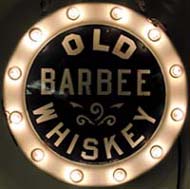
|
The double-faced Federal Sign lightbulb
sign for Old Barbee Whiskey is porcelain and dates
from the first decade of the 20th century.
|
|
The metal channel letter was saved
from the Moore Theatre in Seattle, WA. The changeable
letter plugged into the 1907 theatre's marquee readerboard.
The stroke of the letter is illuminated with a single row of
incandescent bulbs.
|

|
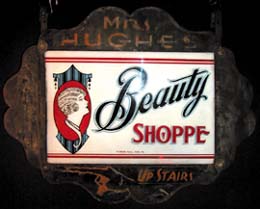
The circa 1930s metal sign for Mrs. Hughes
Beauty Shoppe has reverse-painted glass faces internally
illuminated with incandescent bulbs. The glass faces are signed by
"W. Frank Hull - Pgh., Pa."
|

|
This incandescent, internally
illuminated sign measures 8 x 24 x 32 in. and
probably dates back to the turn-of-the-century. The
double-faced can is constructed of heavy metal with
glass faces. "Chemist" and the druggist's
bottle are outlined in foil; background and copy
are reverse painted, leaving the light to shine
through the bottle graphic.
|
|
The porcelain-enamel "bulb
sign" represents the pre-neon electric sign
era. Thanks to an earlier donation of a 1905
Federal Sign catalog by Rick Glawson, Fine Gold
Sign and Esoteric Sign Supply, the Museum was able
to identify the DRUGS sign as a Federal Sign
stock product.
|
|
|
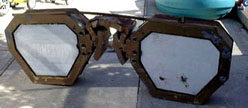
|
The 2 x 8-ft.
three-dimensional eyeglasses probably date
to the turn-of-the-century. When the sign was
acquired, it had plastic lenses in place of the
original glass lenses, which would have had
goldleaf and/or painted "eyes." The electrode
housing holes around the bridge indicate that the
sign had later been retrofitted for neon-probably
in the 1930s. The sign is currently undergoing
restoration by David Benko, the Museum's Electric
Sign Curator.
|
|
The double-faced,
internally-illuminated sign dates to the 1930s.
The punched-out louvers, which form the text for
the sign, permit illumination by incandescent
bulbs; the smalts background provides an
illuminated effect during the daytime. This Cole
Batteries sign was manufactured by The
McSavaney Co., Springfield, OH.
|
|
|
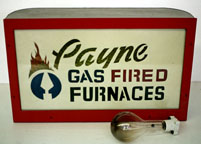
|
The Payne Furnace
point-of-purchase sign was manufactured in
the 1930s, according to Chuck Beauchemin, who
donated the sign. The sign's face is hand-cut card
stock, backed by colored theatre lighting gel.
Illumination was originally provided by an
incandescent bulb, but the sign was later
retrofitted with fluorescent tubes.
|
|
The 15 x 30-in. punch-out
louvred sign was intended for interior display
and features a handpainted woodgrained face. The
sign was manufactured by The McSavaney Company,
Springfield, OH and was discovered in a Soho (NY)
toy store specializing in mint-condition
vintage toys.
|
|
|
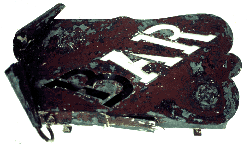
|
The 20 x 32-in. sheetmetal
cabinet "Bar" sign has flat opal glass
open-face letters illuminated by incandescent
bulbs. The circa 1910 sign is missing one section
of opal glass and has multi-layers of paint. It is
currently being restored.
|
|
The 34 x 72-in. double-sided,
porcelain-enamel Goodyear Tires sign
features a bright copper border and embossed ("A.R.
Burton & Son") and flat ("Goodyear Tires")
glass letters. The internally illuminated sign was
manufactured by Flexlume, Buffalo, NY, in the late
1920s.
|
|
|
Home
| News | Exhibits
|
Links
| FAQ | Contact
Us
|
|